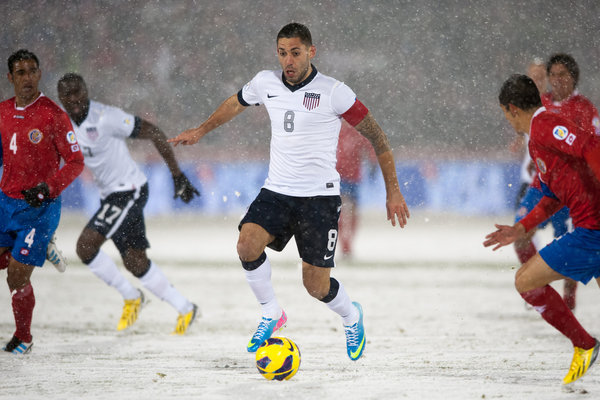The U.S. national soccer team won a key World Cup qualifying match over Costa Rica last night in conditions that were, oh, unusual for a game played in the Concacaf “hexagonal” — made up mostly of teams from Central America and the Caribbean.
A heavy snowstorm. Don’t see that in Kingston.
The Yanks defeated Costa Rica 1-0 in what, by the end, turned into near white-out conditions, with snow accumulating by the inch. (Not that I am expert in frozen water from the sky, but I think it fell short of a “blizzard” because the wind was not intense.)
And now the Ticos are complaining about the whole of it, and saying they will protest the game to FIFA, presumably to see if they can get a replay. The conditions not being fit to play in, etc.
Which is fairly laughable, considering the extreme levels of venue gamesmanship that go in on this confederation.
Consider:
–Mexico plays its qualifiers Azteca Stadium, which is located 7,300 feet above sea level. Despite the altitude, it can be brutally hot there, in the summer, and Mexico City has some of the worst air in the western hemisphere. Also, the place seats more than 100,000, and about 80,000 of them seem to be within 20 feet of the field. The U.S. lost 23 of its first 24 meetings there with Mexico (the 24th was a draw) before winning a friendly last August.
–Honduras has a semi-temperate capital city, Tegucigalpa, with moderate elevation (3,200 feet) — but most of the year the Hondurans will drag opponents down to play in the steamy and grimy industrial city of San Pedro Sula — where both the U.S. and Mexico had severe trouble with heat, in recent games, and the Hondurans duly won the first game and drew the second (coming back from 2-0 down against the exhausted Mexicans).
–Costa Rica historically played in the cramped Estadio Ricardo Saprissa in San Jose, the capital, which has a bit of altitude (3,800 feet). It was infamous for the uncomfortable proximity of fans to visiting sides, and U.S. soccer veterans like Paul Caligiuri talk about incidents of coins and bags of urine being thrown at them. This time around, the Ticos are playing in a new facility, but it still looks a bit cozy, and it is hard to imagine fans will allow any slippage in the country’s reputation for being a bad place for visiting teams.
–Jamaica plays at Independence Park, which is known for its awful pitch — one on which a ball rarely rolls smoothly. It also is known to rain there, more than a little. It also was built in 1966.
–And Panama? The Panamanians also play in an ancient dump (see: Jamaica) named Estadio Rommel Fernandez. Panama City gets more than 75 inches of rain per year and the average daily high every month of the year is north of 90 Fahrenheit. Thus, every day is a bad day to play soccer there, and it gets less bad only if you are used to it. Like, say, Panama’s players.
So, the question is, what is Costa Rica complaining about? It snowed. It wasn’t going to kill anyone. The grounds crews shoveled off the touch lines and the penalty box whenever they had a chance.
Plus, the possibility of snow in Denver in March 22 … sure, it’s there. But Denver weather is notoriously unpredictable, and U.S. federation claims that they wanted to play there — above 5,000 feet — mostly to be better prepared to play in Mexico City on Tuesday ring true.
Also, it’s not like Americans, particularly the Latin players, have some long Scandinavian background of playing in snowstorms.
I can understand the Ticos attempting to get the system to work for them, but the whole of Concacaf is a nightmare for visiting teams. So, snow fell on the Ticos. At least it wasn’t bags of urine.
(Photo credit: Getty Images)


2 responses so far ↓
1 Gene // Mar 24, 2013 at 2:25 PM
Two additional items. First, it is my understanding that, despite having a new national stadium, the Ticos plan to play Mexico and the US at Saprissa—why lose the home field advantage? Second, more of the Costa Rican players are now playing in the Scandinavian leagues than are US players.
2 Chuck Hickey // Mar 24, 2013 at 5:09 PM
It’s the snowiest month of the year in Denver, and storms like this aren’t unprecedented. Actually, they’re common this time of year. Ten years ago, in March, a storm dropped 32 inches on Denver.
Leave a Comment